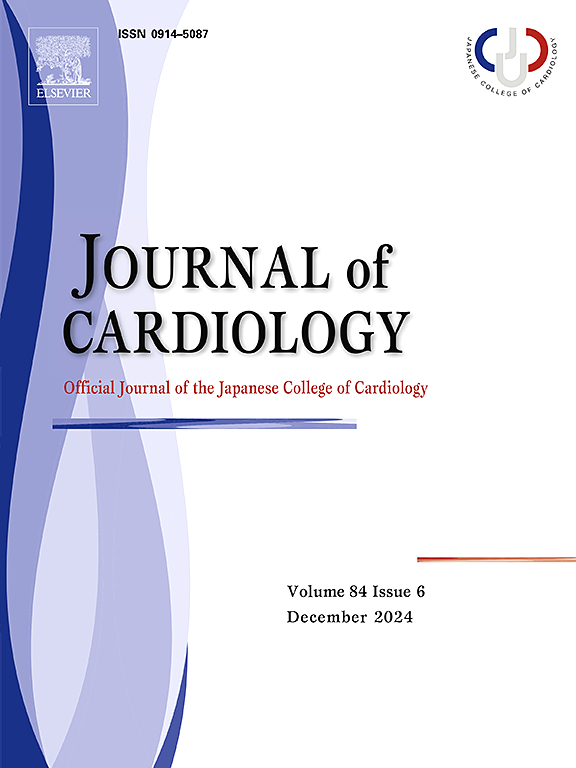Extensive ablation for elderly patients with persistent atrial fibrillation: insights from the EARNEST-PVI prospective randomized trial
IF 2.6
3区 医学
Q2 CARDIAC & CARDIOVASCULAR SYSTEMS
引用次数: 0
Abstract
Background
In patients with persistent atrial fibrillation (AF), extensive ablation for substrate modification, such as linear ablation or complex fractionated atrial electrogram ablation in addition to pulmonary vein isolation (PVI) remains controversial. Previous studies investigating extensive ablation have demonstrated its varying efficacy, suggesting the possible heterogeneity of its efficacy. Aging is a major risk factor for AF and is associated with atrial remodeling. We aimed to compare the efficacy and safety of the extensive ablation strategy compared with PVI alone strategy between young and elderly patients.
Methods
This study is a post-hoc analysis of the multicenter, randomized controlled, noninferiority trial investigating the efficacy and safety of PVI-only (PVI-alone arm) compared with extensive ablation (PVI-plus arm) in patients with persistent AF (EARNEST-PVI trial). We divided the overall population into 2 groups based on age and assessed treatment effects.
Results
In the young group (age <65 years, N = 206), there was no significant difference in the recurrence rate between the PVI-alone group and PVI-plus group [hazard ratio (HR): 1.00, 95 % CI: 0.57–1.73, p = 0.987], whereas the recurrence rate was significantly lower in the PVI-plus group compared to the PVI-alone group in the elderly group (age ≥65 years, N = 291) (HR: 0.47, 95 % CI: 0.29–0.76, p = 0.0021) (p for interaction = 0.0446). There were no fatal procedural complications.
Conclusion
In patients with persistent AF, the extensive ablation strategy was more effective than the PVI-alone strategy in elderly patients, while the effectiveness of both approaches was comparable in young patients.
Trial registration
URL: https://clinicaltrials.gov; Unique identifier: NCT03514693.
URL: https://center6.umin.ac.jp/cgi-open-bin/ctr_e/ctr_view.cgi?recptno=R000022454
Unique ID issued by UMIN: UMIN000019449.

对老年持续性心房颤动患者进行广泛消融:EARNEST-PVI 前瞻性随机试验的启示
对于持续性心房颤动(房颤)患者,在进行肺静脉隔离(PVI)的同时进行广泛消融以改变基底(如线性消融或复杂分段心房电图消融)仍存在争议。以往对广泛消融的研究显示其疗效各不相同,这表明其疗效可能存在异质性。衰老是房颤的主要风险因素,并与心房重塑有关。我们旨在比较广泛消融策略与单纯 PVI 策略在年轻和老年患者中的疗效和安全性。本研究是一项多中心、随机对照、非劣效性试验(EARNEST-PVI 试验)的事后分析,该试验研究了在持续性房颤患者中单纯 PVI(PVI-one 组)与广泛消融(PVI-plus 组)相比的疗效和安全性。我们根据年龄将总体人群分为两组,并评估了治疗效果。在年轻组(年龄小于 65 岁,= 206 人)中,PVI-alone 组和 PVI-plus 组的复发率无显著差异[危险比 (HR):1.00,95 % CI:0.57-1.73,= 0.987],而 PVI-plus 组的复发率则显著高于年轻组。987],而在老年组(年龄≥65 岁,= 291),PVI-plus 组的复发率明显低于 PVI-alone 组(HR:0.47,95 % CI:0.29-0.76,= 0.0021)(交互作用 = 0.0446)。没有致命的手术并发症。在老年持续性房颤患者中,广泛消融策略比单纯 PVI 策略更有效,而在年轻患者中,两种方法的有效性相当。URL:唯一标识符:.
本文章由计算机程序翻译,如有差异,请以英文原文为准。
求助全文
约1分钟内获得全文
求助全文
来源期刊

Journal of cardiology
CARDIAC & CARDIOVASCULAR SYSTEMS-
CiteScore
4.90
自引率
8.00%
发文量
202
审稿时长
29 days
期刊介绍:
The official journal of the Japanese College of Cardiology is an international, English language, peer-reviewed journal publishing the latest findings in cardiovascular medicine. Journal of Cardiology (JC) aims to publish the highest-quality material covering original basic and clinical research on all aspects of cardiovascular disease. Topics covered include ischemic heart disease, cardiomyopathy, valvular heart disease, vascular disease, hypertension, arrhythmia, congenital heart disease, pharmacological and non-pharmacological treatment, new diagnostic techniques, and cardiovascular imaging. JC also publishes a selection of review articles, clinical trials, short communications, and important messages and letters to the editor.
 求助内容:
求助内容: 应助结果提醒方式:
应助结果提醒方式:


